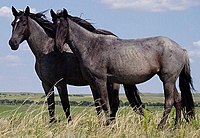
Photo from wikipedia
The objective of this study was to assess the genetic parameters of insect bite hypersensitivity (IBH) in the Old Grey Kladruber horse, an original Czech warmblood horse breed. Insect bite… Click to show full abstract
The objective of this study was to assess the genetic parameters of insect bite hypersensitivity (IBH) in the Old Grey Kladruber horse, an original Czech warmblood horse breed. Insect bite hypersensitivity is a recurrent allergic skin disease affecting horses worldwide. Its etiology is multifactorial. The defect is genetically controlled, and the starting impulse is a bite by midges of the spp. and less frequently spp. Knowledge about the associated genes is limited. Horses were kept by the National Stud in Kladruby (1,146 measurements) and by 10 private breeders (63 measurements). The horses were visually scored by the same inspector over a period of 13 yr from 1996 to 2009. A linear logistic model with a binary variable was used for subsequent statistical analysis. The fixed effects of the farm, year of evaluation, age of evaluation, and sex were significant, and the nonsignificant effect was the intensity of greying. The animals from the National Stud were more strongly affected by IBH than animals from private studs. The National Stud is located near the Labe River, at an altitude of 206 m; there are bottomland pastures in the vicinity, blind river arms, and numerous pools and marshes, and the climate is mild. These conditions are convenient for horse keeping but also for the propagation of . The stallions were less affected than the mares. The occurrence in years of age was influenced by selection; scoring began in the first year of age, and when the young animal was repeatedly positive, it was eliminated from breeding. The estimated h differed significantly from 0, and the direct h were 0.626 in the animal model with a maternal effect, 0.359 in the animal model without a maternal effect, and 0.363 in the animal model without correlation between direct and maternal effect. The maternal h was 0.305. The estimated repeatabilities were 0.636 with a maternal effect, 0.615 without a maternal effect, and 0.623 without correlation. The h of IBH was found to be medium to high, so there is a possibility to reduce the prevalence of IBH by selection.
Journal Title: Journal of animal science
Year Published: 2017
Link to full text (if available)
Share on Social Media: Sign Up to like & get
recommendations!